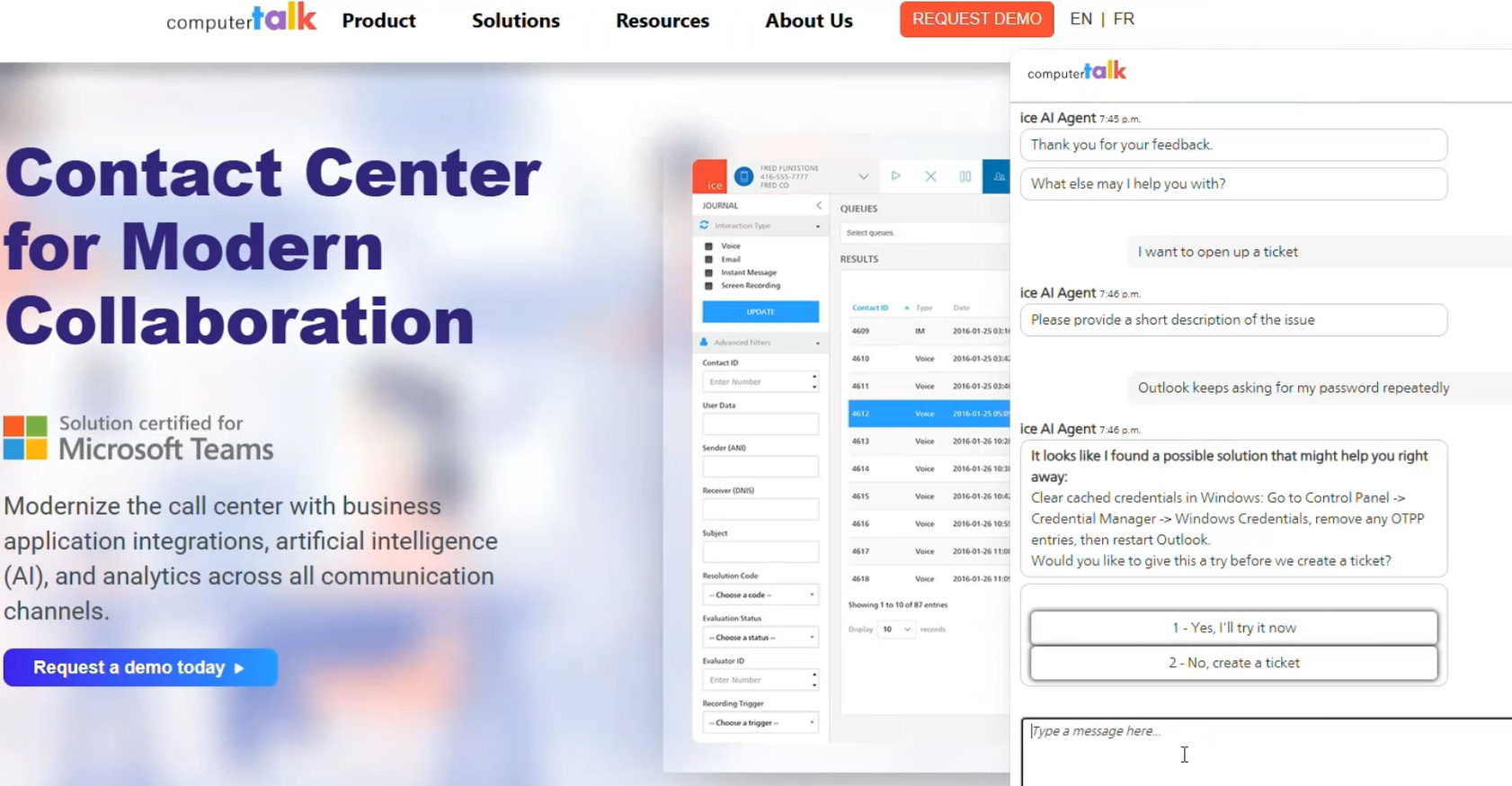Omnichannel vs. Multichannel Contact Center: What's the Difference?
by Kent Mao | Published On February 7, 2024 | Last Updated March 26, 2024

Both multichannel and omnichannel contact centers offer a variety of ways to communicate with customers.
In the past, contact centers primarily focused on two channels of communication: phone calls and emails. But these days, customers interact with companies through a variety of different channels, including live chat, SMS, social media and even video.
Not only do customers expect companies to be active on all of these channels, but they also want every interaction to be seamless and consistent in the level of support offered.
In this article, we'll explore the differences between the two types of contact centers and why many companies are updating their multichannel contact centers to focus on omnichannel instead.
What is a Multichannel Contact Center?
A multichannel contact center is a software platform that lets companies connect with customers across two or more channels. These channels may include voice, email, chat, video, or social media.
The main difference between multichannel and omnichannel contact centers is that multichannel solutions don’t provide a seamless cross-channel experience. Each channel is siloed and the information from each channel cannot be passed to another. Often, different platforms are used for the various channels.
Though there are benefits to this type of contact center — such as the ability to assign specific employees to channels based on their expertise and skills — there are many downsides.
Lack of data integration means context is often lost as customers move from one touchpoint to another, leading to more cumbersome and repetitive agent interactions.
The Pros and Cons of Multichannel Contact Centers
When compared with omnichannel contact centers, multichannel contact centers offer a few advantages:
- Quick access to communication channels: Adding a new channel to your contact center is often simpler and easier with a multichannel approach. Companies can support consumers across various environments without relying on APIs and integrations.
- Channel-specific expertise: Multichannel contact centers allow companies to assign specific agents to certain channels based on their expertise and experience. This also helps increase ownership and accountability among different service groups.
- Lower upfront costs: Multichannel solutions are often cheaper and simpler to implement than omnichannel solutions, as they don’t require advanced integrations between different systems.
The downsides of multichannel contact centers often outweigh their benefits. For example, agents usually require more training to ensure they can effectively use different platforms and tools. Employees will also work in an environment where information isn’t transferred between channels, making it hard to preserve context and deliver efficient, personalized experiences.
Plus, when data is stored and collected in a range of different environments, it’s much harder to maintain compliance and security standards. There are more opportunities for gaps to emerge that could lead to data breaches and privacy issues.
Multichannel contact centers also force customers to repeat questions, requests, and authentication information, which means issues take longer to resolve and customer satisfaction deteriorates.
What is an Omnichannel Contact Center?
 Omnichannel contact centers are customer service platforms that allow companies and consumers to communicate across multiple channels. These channels include social media, live chat, email, phone, and video conferencing.
Omnichannel contact centers are customer service platforms that allow companies and consumers to communicate across multiple channels. These channels include social media, live chat, email, phone, and video conferencing.
They’re considered the "next generation" of multichannel contact centers because they don’t just provide access to numerous channels. Omnichannel contact centers align those touchpoints and their data through integrations to create a seamless platform.
Omnichannel contact centers share contextual data and insights from one environment to another, allowing for a seamless customer experience. Support teams can manage incoming and outgoing communications across various channels and continue a conversation, even as the interaction moves from one channel to another.
Why Choose Omnichannel Contact Centers Over Multichannel?
Just like multichannel contact centers, omnichannel contact centers offer several communication channels. However, the omnichannel model is customer centric and focuses on providing a seamless customer experience.
The channels are interconnected, enabling the information gathered by the initial agent to also be accessed by others. Agents can pick up where the previous agent left off, which creates a seamless customer journey.
Surveys show that today’s “hybrid customers” interact with brands across more than 20 channels, on average. While multichannel contact centers enable access to these various touchpoints, omnichannel contact centers ensure a more consistent experience by sharing context and data.
Demand for seamless and personalized customer experiences is driving increased focus on the importance of omnichannel contact centers. Up to 91% of contact center professionals now say omnichannel integration is one of their top customer experience priorities.
The Benefits of Omnichannel Contact Centers
It’s no surprise that most companies are choosing omnichannel contact centers over multichannel alternatives.
Omnichannel contact centers offer many benefits:
- An integrated view of customer data: Comprehensive insights into all customer interactions across physical and digital channels. This includes information about purchase histories, preferred channels, customer satisfaction scores, and more. Because agents have a full view of the buyer journey, they can deliver a more personalized, seamless experience.
- Quicker response and resolution rates: Since all the data needed is readily available to agents, customers don’t have to spend as much time repeating information. Agents can access any resource they need quickly, which improves service response times, first-call resolution rates, and customer satisfaction.
- Improved agent productivity: Because agents don’t have to switch back and forth between different applications, they can save time on customer interactions. They can avoid wasting time searching for relevant information and focus on the conversation at hand.
- Better customer service: With access to customer data, agents can provide highly personalized experiences, leading to increased customer satisfaction. They can also use insights gathered from omnichannel journeys to identify opportunities to elevate the customer experience.
- Opportunities for differentiation: With omnichannel contact centers, companies can quickly embrace new channels based on their customers’ preferences without creating data silos. Most omnichannel solutions make it easy to integrate new channels, like social media, SMS, or in-app messaging.
Understanding the Differences Between Omnichannel and Multichannel
Distinguishing between omnichannel and multichannel contact centers can be complex. Both allow companies to manage incoming and outbound conversations across various channels.
The main difference is that an omnichannel contact center bridges the gaps between these channels, allowing for a shared flow of data and context.
Let’s take a closer look at the main differences between omnichannel and multichannel solutions:
Features | Omnichannel | Multichannel |
Integration |
|
|
Context |
|
|
Channel ownership |
|
|
Customer experience |
|
|
Personalization |
|
|
Cost |
|
|
Insights |
|
|
Omnichannel vs Multichannel: Which is Best For You?

When deciding on the right contact center, it's important to consider your organization's needs, your budget, the different communication platforms you use, and the average number of inbound/outbound interactions per day.
While the right contact center for your needs will depend on many of these factors, omnichannel contact centers usually offer the most future-proof solution.
Multichannel contact centers might be a better option for smaller, budget-conscious teams with fewer channels to navigate. They still give companies the opportunity to interact with customers across a range of channels. However, an omnichannel solution paves the way for more seamless experiences.
An omnichannel solution offers customers multiple ways to contact an organization while providing a seamless experience across channels. A customer can email an organization about an issue and then reach back out via a phone call for an update. The agent handling the phone call will have the previous interaction information and will know the issue the customer is talking about. This prevents the customer from needing to repeat the same information.
Overall, omnichannel contact centers are the ideal option for companies who want to not only deliver a more personalized and cohesive experience to customers, but also empower employee productivity and deepen customer journey insights.
Summary
Both omnichannel and multichannel contact centers provide multiple ways to connect with customers. However, for contact center teams focused on delivering seamless and personalized customer experiences, omnichannel solutions are an essential investment.
Omnichannel contact centers can bridge the gap between customer data and context, which is a common problem in multichannel contact centers. What’s more, by reducing the need to switch between different apps to address different customer touchpoints, omnichannel contact centers make teams more productive and efficient.
Ultimately, omnichannel contact centers empower businesses to deliver better services and support to customers across any channel they choose.
To learn more about different contact center solutions, check out our blog post on cloud contact centers vs on-premises.
More from our blog
 Uncover how chat and bot capabilities in ice Contact Center simplify workflows and create more efficient, personalized customer experiences.
Uncover how chat and bot capabilities in ice Contact Center simplify workflows and create more efficient, personalized customer experiences.
 As someone who has been going to in-person Microsoft conferences for 15 years, the last couple of years have been a real change in routine. There was always a regular cadence of two or three events a year, typically Build...
As someone who has been going to in-person Microsoft conferences for 15 years, the last couple of years have been a real change in routine. There was always a regular cadence of two or three events a year, typically Build...
 Learn how customer service expectations differ for Gen Z, Millennials, Gen X, and Boomers. Discover strategies, examples, and tips to adapt your support to each generation.
Learn how customer service expectations differ for Gen Z, Millennials, Gen X, and Boomers. Discover strategies, examples, and tips to adapt your support to each generation.

